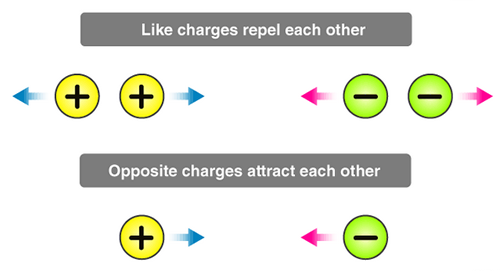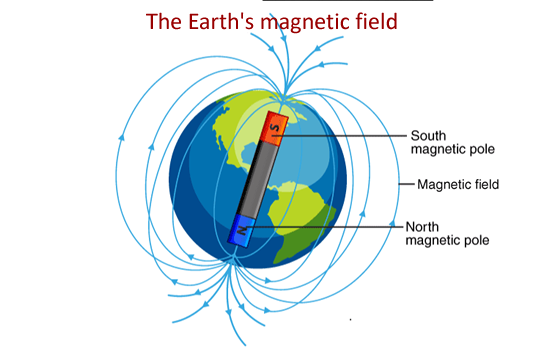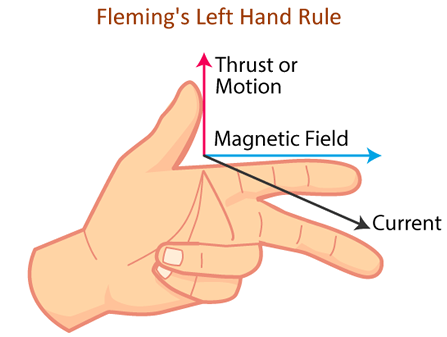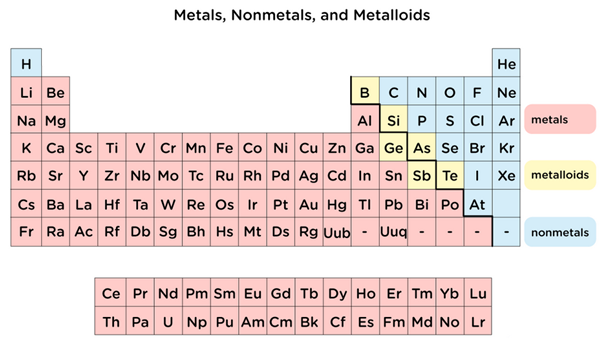Unit 5 - May the force be with you
Content
- 9u5.1 - Contact and non-contact forces
- 9u5.2 - Magnetic field
- 9u5.3 - Electrostatics field
- 9u5.4 - Electromagnetism
- 9u5.5 - Atoms, elements and compounds
- 9u5.6 - Atomic theory
- 9u5.7 - Electronic configuration up to z = 20
- 9u5.8 - Formation of simple ions
- 9u5.9 - Polyatomic ions
- 9u5.10 - Ionic bonding
- 9u5.11 - Ionic structure and properties
- 9u5.12 - Covalent bonding
- 9u5.13 - Covalent structure and properties
- 9u5.14 - Now test yourself
Scheme of work
9u5.1 - Contact and non-contact forces
Interactions between two objects.
Forces cause objects to move actually accelerate) according to Newton's law
Force = mass x acceleration
Forces may act directly on an object by actual contact, eg pushing with your hand, or they can act on an object spookily without actually coming into physical contact. This may seem like magic, but it is actually science!
There are three forces that act over a distance that we experience in everyday life:
- Gravity
- Magnetism
- Electrostatic
Gravity
We have already seen gravity in unit 4 and will not be discussing it here.
Magnetism
Magnets exert a force on other magnets and some types of metal. Magnets have two "poles" called north and south. Like poles repel each other and opposite poles attract.

Magnetism activity
You are provided with magnets, iron filings and a compass. Follow the directions in the worksheet.
Electrostatic force
The term "electrostatics" literally means charges that do not move. Electricity consists of electrical charge that does move.
Electrical charges are a phenomenon of nature. There are two different electrical charges that are opposite to one another, called positive and negative. By convention the positive electrical charges are given a positive (plus) sign and the negative electrical charges a minus sign.
Electrical charges can be detected by the effect that they have on each other. Like charges repel one another and opposite charges attract one another.

Forces between charged particles
Open the PhET activity
Use the slider to see the effect of distance on the force between charges
9u5.2 - Magnetic fields
A force field is a region of space in which a non-contact force can be detected. Magnetic forces can be detected by materials influenced by a magnet (magnetic materials). Electrostatic force fields can be detected by objects that are also electrically charged.
Compasses
These are small devices that have a tiny magnet balanced on a piece of metal allowing the magnet to rotate freely. When a compass detects a magnetic field the tiny magnet in the compass aligns with the magnetic field and points towards the north pole of the magnet that is producing the field.

The Earth's magnetic field
A compass can be used to find the direction of the north pole as the Earth produces its own magnetic field. The compass needle points towards the north.

Paradoxically, the north pole of the Earth is actually a south magnetic pole! We call the north pole like this because the north poles of compasses point towards it.
Activity: magnetic fields
A compass can be used to plot the shape of the magnetic field around a magnet. This will be dependent on the shape of the magnet itself.
9u5.3 - Electrostatic fields
Electrical charges
The term "electrostatics" literally means charges that do not move. Electricity consists of electrical charge that does move.
Electrical charges are a phenomenon of nature. There are two different electrical charges that are opposite to one another, called positive and negative. By convention the positive electrical charges are given a positive (plus) sign and the negative electrical charges a minus sign.
Electrical charges can be detected by the effect that they have on each other. Like charges repel one another and opposite charges attract one another.

Electrostatics circus demonstration
Several experiments that demonstrate electrostatic force.
9u5.4 - Electromagnetism
The electromagnetic effect
When an electric current flows through a wire it creates a magnetic field around the wire. If a second magnet, for example a compass needle, is placed near the wire there is an interaction between the two fields.
The force experienced by the two magnetic fields can be predicted if the direction of conventional current is known and the direction of the magnetic field is also known. There is a rule called Fleming's left hand rule. Note that conventional current flows in the opposite direction to the electrons, i.e. from positive to negative terminals.

Experiment - Factors affecting an electromagnet
You are to make an electromagnet by winding coils of wire around an iron nail.
Motors
The electromagnetic effect is put to good use in motors. A coil of current carrying wire in a magnetic field experiences a force perpendicular to both the current and the magnetic field. This can be made to rotate a coil of wire.

9u5.5 - Atoms, elements and compounds
Metals and non-metals
In Unit 1 we learned about the periodic table and how it is divided up into metals, non-metals and metalloids. Each element in the periodic table is made up exclusively of its own type of atoms. Carbon is made of carbon atoms, hydrogen is made of hydrogen atoms etc..

A compound is a substance that is made up of more than one type of element.
The smallest particles of a compounds are either molecules (with two or more different types of atom) or repeating units of charged particles, called ions.
In the following sections we will look at how the elements in the periodic table combine to make compounds.
There are three different possible general combination of element types:
- Metal element bonded to another metal element
- Metal element bonded to non-metal element
- Non-metal element bonded to another non-metal element
Metals combined with other metals
Metals combine with other metals in all proportions to make alloys. These are not generally considered to be compounds, as the metals can be separated by physics means and there is no fixed chemical formula for an alloy. This goes against the law of constant composition, which says that a compound has only one formula, i.e. ratio of atoms.
The reason that metals behave this way is because of the bonding between metal atoms, which we will look at later on in the course.
9u5.6 - Atomic theory
The periodic table is a data table of the elements. They are arranged in order of increasing atomic number, from hydrogen (number 1) to Oganesson (number 118). But what does the atomic number mean? The periodic table also includes the relative mass of each of the elements. Why do they have different masses?
In order to answer these questions we must look at how the atoms themselves are constructed, the sub-atomic structure.
Sub-atomic particles
Atoms are made up of three types of sub-atomic particle, each with its own characteristics.
- Protons
- Neutrons
- Electrons
Atomic structure

Protons
Each type of atom has a different number of protons and it is from here that we get the atomic number, Z. A proton carries a positive electrical charge and it has a mass of 1 atomic mass unit. The number of protons give us the identity of the atom. The protons are found at the very centre of the atom, called the nucleus.
- Carbon, atomic number 6 has 6 protons in each atom.
- Hydrogen, atomic number 1 has 1 proton in each atom.
Electrons
As the protons carry positive electrical charges and atoms are neutral no charge,, there must be negative particles that cancel out the protons charges. These are the electrons. Electrons are tiny and have almost no mass, actually about 1/1836 the mass of a proton, but each electron carries a negative charge. Hence, the number of electrons in an atom must be the same as the number of protons. The electrons are to be found far from the nucleus, orbiting the atom in energy shells.
- Carbon, atomic number 6 has 6 protons and 6 electrons in each atom.
- Hydrogen, atomic number 1 has 1 proton and 1 electron in each atom.
Neutrons
Neutrons have no electrical charge, but a mass that's nearly the same as a proton. They are found in the nucleus where they help to prevent the positive protons repelling each other. To do this they use another type of force, called the strong nuclear force. The number of neutrons in a nucleus is variable, making it possible to have several versions of of the same atoms, called isotopes, with different masses.
- Carbon, atomic number 6 has 6 protons and 6 electrons and 6 neutrons in each atom.
- Hydrogen, atomic number 1 has 1 proton and 1 electron but no neutrons in each atom.
However, there are other versions of hydrogen, called deuterium and tritium that have 1 and 2 neutrons, respectively. These are isotopes of hydrogen.
The isotopes of hydrogen

Summary - sub-atomic particles and properties
9u5.7 - Electronic configuration up to z = 20
The number of electrons in a neutral atom is the same as the atomic number. The electrons are located in energy shells that are outside of the nucleus. The higher the energy, the further from the nucleus they are found. However, each energy shell can only house a certain number of electrons.
- 1st shell (lowest energy, nearest the nucleus) - 2 electrons
- 2nd shell (further from the nucleus) - 8 electrons
- 3rd shell (further from the nucleus) - 8 electrons
- 4th shell (further from the nucleus) - 18 electrons
We are only concerned with elements from z=1 to z=20, hydrogen to calcium.
The aufbau principle
This is the way that the electrons shells get filled with electrons. This is called the electronic configuration, or electron arrangement. There are two fundamental rules:
- Rule 1 - Fill the energy shells starting from the bottom up.
- Rule 2 - Do not start a higher energy shell until the lower shell(s) are filled up.
9u5.8 - Formation of simple ions
The stability of atoms
The word "stability" means resistance to change. If something is stable then it tends to remain the same and not change in any way. Atoms are unstable on their own, this means that most types of atom will undergo change if possible to become more stable.
The exception to this are the atoms of the elements in group 8, the noble or inert gases.
- Helium
- Neon
- Argon
- Krypton
- Xenon
- Radon
Atoms of these elements are quite stable on their own, so these gases are said to be monatomic (exist as single atoms). It seems that the electronic configuration of these gases is particularly stable. They all have full outer shells.
Stable electronic arrangements
- Helium - (2)
- Neon - (2,8)
- Argon - (2,8,8)
Making ions for stability
Atoms whose outer shell is not complete can become stable by gaining electrons in, or losing electrons from the outer shell.
Metals occur on the left hand side of the periodic table and have very few electrons in their atoms' outer shells. If they get an opportunity to lose the outer electrons they will do so, leaving particles with positive charges, called cations.
Non-metals are to be found on the right hand side of the periodic table and have almost full outer shells. If they get an opportunity to gain more electrons to fill the outer shell they will do so, making particles with overall negative charges, called anions.
Examples: sodium and chlorine
Sodium has an electronic arrangement (2,8,1) so it either must lose 1 electron or gain 7 electrons to attain a full outer shell.
It is much easier for sodium atoms to lose 1 electron than gain 7 electrons.
Na (2,8,1) → Na+(2,8) + 1e-
Chlorine has an electronic arrangement (2,8,7) so it either must lose 7 electrons or gain 1 electron. It is much easier to gain 1 then lose 7, so it gains one more outer electron.
Cl (2,8,7) + 1e- → Cl-(2,8,8)
Summary of ion formation
Atoms form ions to gain stability. However, they cannot just pick up electrons or shed electrons from nowhere. Ions can only form if the atoms have other atoms from which they can take electrons (a metal), or other atoms to to which they can donate an electron(s) (a non-metal).
We will see in the ionic bonding section how metals can join up with non-metals to their mutual benefit.
9u5.9 - Polyatomic ions
Poly = many, atomic = atoms, hence many atom particles with a charge.
These are groups of atoms that are bonded together, but have lost or gained electrons so that all of the atoms in the group have a full outer shell.
Once the polyatomic ion is formed (not our concern) they behave just like simple ions.
List of some common polyatomic ions
- hydroxide, OH-
- nitrate, NO3-
- carbonate, CO32-
- hydrogencarbonate, HCO3-
- sulfate, SO42-
- phosphate, PO33-
- ammonium, NH4+
9u5.10 - Ionic bonding
Metals combined with non-metals
This combination of elements makes ionic compounds, in which the smallest particles all carry electrostatic charges.
Ionic bonding happens in several stages:
- 1. Transfer of electrons from metal atoms to non-metal atoms
- 2. All species attain full outer shells
- 3. The metal atoms become positive ions - cations
- 4. The non-metal atoms become negative ions - anions
- 5. All of the cations attract anions and all of the anions attract cations
- 6. A giant lattice of repeating ions is formed
The only complication with ionic bonding is to have the correct number of metal atoms to provide electrons for the appropriate number of non-metal atoms. If you write the electronic arrangement out for each type of atom you will be able to see how to do this. Look at the examples below.
What is the correct formula for the compound formed between sodium and oxygen?
Sodium has the electron arrangement 2,8,1 - it needs to lose 1 electron.
Oxygen has the electron arrangement 2,6 - it needs to gain 2 electrons.
This is possible if we have two sodium atoms for each oxygen atom.
Na(2,8,1) + Na(2,8,1) + O(2,6) → Na+ + Na+ + O2-
So the formula of sodium oxide is Na2O
9u5.11 - Ionic structure and properties
Property
This term is regularly used in science to describe characteristics of a substance that can be observed or measured. Properties can be either physical or chemical, the difference being that chemical properties involve a change in the chemical nature of the component under study.
It is important to understand that the word 'property' refers to materials in the macroscopic world, and not their particles.
Ionic properties
- Hard but brittle
- High melting point
- Crystalline
- Non-conductors when solid
- Soluble in water (usually)
- Conductors in solution
- Conductors when molten (melted)
Experiment - the properties of ionic substances
The students will be given the outline of an experiment and some data to analyse
9u5.12 - Covalent bonding
Bonding between two or more non-metal elements
The word "covalent" means sharing valence (outer shell) electrons.
The atoms do this so that each of the atoms can achieve a full outer shell.
Covalent bonding in the hydrogen molecule

In the first period the energy shell can only hold 2 electrons, so this is the full shell. Each of the hydrogen atoms after sharing electrons now appears to have a full outer shell.
9u5.13 - Covalent structures and properties
Covalent structure
Covalent substances have molecules whose atoms are held together by shared pairs of electrons. The molecules themselves are attracted to one another by only weak forces.
Covalent properties
Covalent substances (may be elements or compounds) tend to have low melting and boiling temperatures (often gases or liquids at room temperature. They form soft waxy solids. They are often poorly soluble in water and do not conduct electricity either when solid, liquid or in solution.
The explanation for these properties is that their particles are only held together by weak forces. For many covalent substances the forces are too weak for them to exist as liquids or solids at room temperature.
Covalent elements and compounds
Summary of the differences between ionic and covalent structure and properties
NOTE: In terms of melting point, high could be considered to be several hundred degrees higher than room temperature, while low means less than 100°C.
9u5.14 - Now test yourself
Click on the button below to access the self-tests for MYP9 and MYP10.